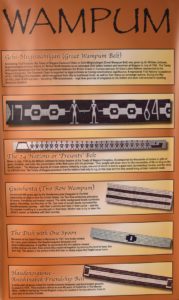Professor explains the basics why we are all Treaty People

By Kelly Anne Smith
NORTH BAY—As Ontario unveiled the first ever Treaties Recognition Week, historian Dr. Catherine Murton-Stoehr gave an easy to understand lecture on Treaties.
Murton Stoehr gave tours at the RBC Treaty Reconciliation Centre in North Bay’s Education Centre Library. The centre is a creative collaboration with Nipissing First Nation, The Union of Ontario Indians, Canadore College, and Nipissing University.
The professor stopped in front of the poster called Wampum. Wampum are tubular white and purple beads made from shells that were beaded into Treaty Belts.
Pointing to the 1763 Treaty Wampum Belt, Murton Stoehr explained its history. “In North America, you had the British who had relationships with the Haudenosaunee while Anishinaabe and the folks living in the Great Lakes had a relationship with the French. This agreement figured out those relationships that had developed over tens of years and some cases, hundreds of years.”
“The French end up leaving. And now you have all the Great Lakes First Nations looking at the British- their enemies for the last one hundred years and they have to figure out how they are going to build a relationship together,” continued Stoehr. “The British’s first offer is the Royal Proclamation. They say they recognize it is all First Nation land west of the Appalachians. They say ‘We’re not going to take any land. We’re not going to let any settler’s take any land.’ It is going to happen nation to nation.”
“First Nation’s around the Great Lakes say, “That’s not good enough at all because we notice you are putting soldiers in those trade forts on our territory and that makes us think you are going to move in here,” added Stoehr. “This is an invasion.”
“So Pontiac and the other warriors take over all of the British forts and says you [the British] can’t be here in that way. Then the British knew they had to make a better offer,” continued Stoehr. “They sent out Wampum messages to nations all around the Great Lakes and say, ‘you meet with us a year from now and we are going to come up with a better deal.”
Murton Stoehr points to the second belt down on the Wampum poster. “That’s what this belt represents. That’s the 1764 Treaty of Niagara Belt. 2,500 Chiefs met with Sir William Johnson who is empowered to share this better deal. They don’t meet for a day. They meet for a month.”
“During that month, Johnson is having separate meetings with all the different leaders. They are pushing for more promises,” noted Stoehr.
The professor points to the next wampum belt down, and explains.
“These are some of the belts for promises they were forced to extend for peace. This is the Presence Belt. Some might think of it as the Subsistence Belt. First Nation folks had ways of feeding themselves and taking care of their families. When the British came they observed it. First Nations said if we are going to let you live here, we are going to pull on this belt and you are going to bring that ship over. You are going to make sure we are never going to lack for the necessities of life.’ That is a promise that Johnson made. He acknowledged the British presence here would get in the way of First Nations getting the stuff they needed. This is the Two Row Wampum that says we are going to live on this land together but we are not the same but separate and we are not going to interfere with each other’s governance systems.”
“This is the Dish with One Spoon which is an old agreement that was brought into this relationship,” continued Stoehr. ‘We all live off of the same resources. It is hard to eat a collective meal together off of a dish with one spoon. We are going to need protocols. We are going to have arrangements that we are going to both respect if we are going to live in that way’.”
Stoehr pointed at another belt, and provided some knowledge on it.
“And then this is a Peace Belt that was created because of those earlier conflicts between the French and the English and their allies. 1701 in Montreal, they say, ‘we are not going to fight. We are going to cooperate for subsistence for everybody’. And then that gets brought into this meeting as well.”
“And when we talk about Treaties in Ontario, we often talk about Land Surrenders,” noted Stoehr. “They are technical agreements about who’s going to live where and when. They are subsidiary to the promises of the Treaties.”
“Keep in mind, that these are agreements made for people who are not from the same community, who do not have natural ties of affection, and who in fact have competing interests. These are ways for us to live in peace,” concluded Stoehr.
Ontario is covered by 46 treaties and other agreements, such as land purchased by the Crown signed between 1781 and 1930. The 94th Call to Action the Truth and Reconciliation Commission 94 recommends Treaties with Indigenous Peoples to be lawfully honoured.
To access the Treaty Learning Centre, call Canadore College, First People’s Centre at 705-474-7600, extension’s 5960 or 5961. Alternately, call Nipissing University, Office of Aboriginal Initiatives at 705-474-3450, extension 4899.


